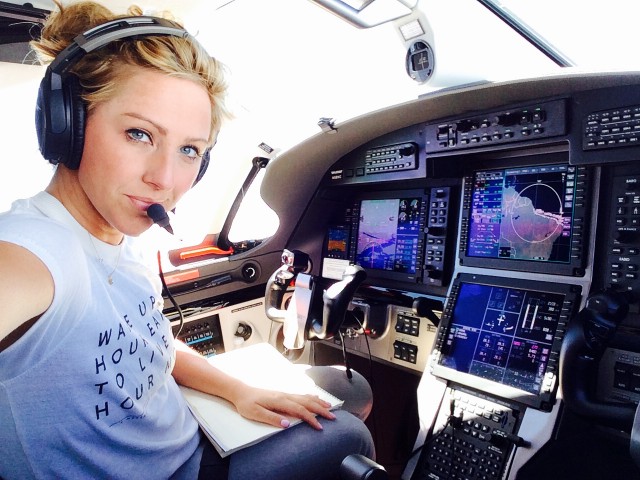
Amelia in command of the Pilatus PC-12NG – Photo: Amelia Rose Earhart
On the 2nd of June, 1937, Amelia Earhart began her journey around the world – the one that would end somewhere over the Pacific. On June 26, 2014, Amelia Rose Earhart began her journey around the world to recreate that famous flight. However, this Amelia completed that journey successfully, touching down after 19 days in Oakland, California.
Piloting a Pilatus PC-12NG, Amelia and her co-pilot Shane Jordan circumnavigated the globe, visiting 14 countries along the way and sealing her fate as the youngest woman to circle the globe in a single-engine aircraft.
Almost a year ago, I was present for Amelia’s announcement of the flight at Oshkosh 2013. Since then, I’ve followed along like so many others on Twitter and other social media. Now that Amelia is back, I was given the chance to talk to her and ask her about her amazing journey.
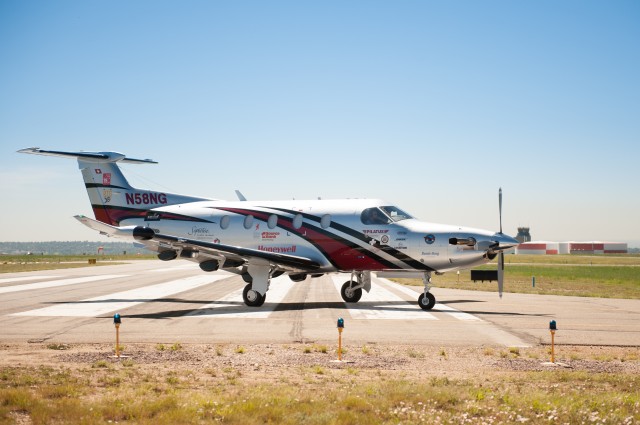
The Pilatus PC-12NG that took Amelia & Shane around the world. Problem free for 108 flight hours – Photo: Amelia Rose Earhart
Mal: So everything went successfully with your flight then?
Amelia: It really did. We had fantastic weather the whole time, the aircraft was perfect, we had no squawks on the entire mission – it was 108 hours of flight and to have no issues the entire time is pretty amazing. I am sure you saw some of the photos coming out, it was stunning views and really nice people along the way.
Mal: I did see some of the photos. So not a single Squawk at all on the PC-12?
Amelia: Not a single squawk, we are all so impressed by that. Also it’s a brand-new airplane which, as you know, comes with its own fair share of issues on the newer side and also on the older side. We had great performance; the engines performed perfectly. We were running daily data checks from the engines, sending them to Pratt & Whitney and we also had no performance issues on the entire route.
Mal: That’s great! What challenges did you have to overcome to get to the start of the flight and make it so successful?
Amelia: We had a team of around 60 people that were working on this flight together from the Honeywell Avionics side all the way through to Jeppesen with the route planning, plotting, and handling. Some of the challenges we saw came from choosing the right time weather-wise to go on this trip. We were really locked in for June or July for this trip.
I am studying to be a meteorologist right now, so I love the weather side of this flight. We looked at climate data for the last 100 years we knew that especially around the equator and the convergence zone we needed to go in these two months. So we were really watching closely for weather.
A couple of the challenges we saw early on in the flight were some volcanic activity out near Singapore, so were were tracking the ash clouds developing over toward the second half of our trip, but those turned out to be no problem whatsoever.
Of course, we were also tracking the thunderstorm activity around the equator and also the tropical systems moving across the Pacific, that basically tracked several thousand miles ahead of us as we were flying. I certainly don’t mean to make it sound like an easy flight, but it was so smoothly executed.
Everywhere we went had plenty of fuel, which is always a concern, especially if you get out toward the islands in the south Pacific, because if you run out of Jet A, you are waiting for the next boat out of Fiji.
A lot of the locations we flew into did not have Prist pre-mixed into the fuel (the anti-icing substance that is mixed into the fuel tank, so that when you’re up at altitude and things get cool you don’t) so we had to carry a full case of Prist (25lb box) which added to our weight and balance. We sprayed the Prist in by hand at a lot of the locations that were sold out.
Mal: What was one of your favorite moments throughout the trip?
Amelia: I have several, but I have narrowed it down to a few poignant moments, one of which was flying over Howland Island, and that’s where Amelia intended to land after she left Papua New Guinea.
We had very cloudy weather as we departed PNG, and we were making our way, first of all, into Tarawa and then the leg from Tarawa heading to Christmas Island was when we had our waypoint over Howland Island into the flight plan to overfly. I was really nervous about the cloud. Although we could fly through anything weather-wise that we needed to in the PC-12, at the same time I needed that visibility, I needed to see Howland with my own two eyes, as it was such a pivotal part of the trip.
So the clouds were pretty thick all the way out and, I am not kidding, but it sounds so coincidental, about 10 miles out from Howland the clouds just cleared out and we had crystal clear visibility all the way down to the surface from 27,000ft. For me, that was a sign from Amelia, you know, something happened there to push those clouds out. In 1937, when Amelia was flying, she wanted with all of her being to find that island, and to come in for that safe landing. So the fact that I got to see that island, as her namesake, trying to honor her flight the best way that I knew how, that was really special for me.
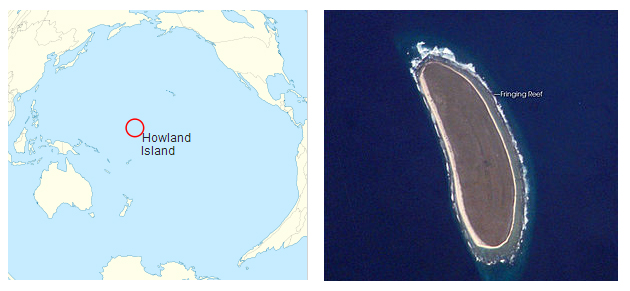
Howland Island – Images: Wiki Commons
Mal: I guess that leads into my next question; how did seeing Howland Island personally affect you?
Amelia: The way that it personally affected me was that I gained a whole new sense of respect for Amelia. Don’t get me wrong; I have respected her my entire life, I have looked up to her, she has been a role model and the most influential woman in my life, but seeing how tiny that island is, in the midst of thousands and thousands of miles of ocean in the south Pacific…
Knowing that she had just the bravery to go and search for that island with the limited navigation that they had back then (celestial navigation), limited radios, and a navigator that was most likely doing his best to find it, but between the two of them they just couldn’t do it. But to know that she was brave enough, taking off looking for that small place, was just incredible. It took my sense of exactly who Amelia was to a whole new level.
Mal: Were there any unexpected situations during the trip, be they good or bad?
Amelia: There were, but I will talk about Papua New Guinea (PNG), because it was the part in the trip where I felt like the planning and all the work we did into getting there safely, and doing the right thing, didn’t really matter at that moment. We were dealing with a situation that was out of our control.
We very specifically wanted to land in Lae, rather than Port Moresby. We were advised not to fly into there, security-wise. Lae makes a lot more sense as there is a bit more tourism in that area, so it makes it just a little bit safer. It was also where Amelia landed, and her historic landing site was just a few miles away from the current airport. Well, we get there and the customs agent in PNG claims that our customs paperwork is filed to clear customs in Port Moresby. They refuse to come out and see us, saying we can just take off and fly to Port Moresby, which was about a 20 minute flight time away. But you know, we have a full gas tank and safe landing weight due to that would mean a three-hour flight to burn off all that gas. We had already flown, I believe, an eight-hour day to that point. It was starting to get dark and we had no intention of flying around PNG in the dark to burn fuel to an airport when our customs agent was meant to meet us in Lae.
So we tried everything, we tried to offer cash, we tried using the fact that the whole world was watching this trip, suggesting it would be in everyone’s best interest if the customs agent would just come to us. It took a long time, but we on the tarmac with about 10 people on the outside making sure we didn’t get out of that plane for four hours. The temperature outside was around 80-90 degrees, humidity almost as much in Papua New Guinea – we were absolutely boiling in that plane. When there is no bathroom on your plane and you fly for eight hours, onboard for four hours more and then another 45 minute drive to your hotel after that, it makes for a very long day.
Mal: That I can understand, and it brings up a good point. Not so much bathroom-wise, but I saw a tweet at one point that said you were in control and your co-pilot Shane was in the back doing push ups. How did you keep yourselves so busy and entertained during those long over-water stretches?
Amelia: *laughing* That is a good point. Luckily, Shane is a great conversationalist so we always had a lot to talk about. There were times though when you get sleepy because the hum of the aircraft almost lulls you to sleep, because it is such a warm cockpit. We would eat; we packed a lot of snacks to keep our energy up, we would also listen to a lot of music. However, both of us are pretty active people so I said ’œShane, I hope this is OK with you but I am going to bring a yoga mat and put it behind the fuel tank and if one of us wants to go back and stretch then we can do it.”
So we would periodically switch off, and Shane would go back for an hour or so and still get things done. But one of our favorite times in the flight was being alone in the cockpit, especially over the open ocean; there is just such a feeling of adventure there. It was a very serene thing for me.
Mal: How did you keep the food situation interesting? Did you pick up food as you went around the world?
Amelia: The answer to your question is we didn’t – we didn’t keep it interesting. Towards the end I don’t think I could stomach another square-shaped protein bar ever again. I have so many leftover snacks in our office that I was hungry recently and tried to eat one. I got about a quarter way through it and just thought ’œI can’t do this.’
We packed as many things as we could that we could get through customs. As you know, you can’t bring any fresh fruit, vegetables, or meat products into a country. We tried to sneak on as much beef jerky as we could, but even that got tiring after a while. Along the way, in cities where we could pick up just a few snacks, we would. One situation, that I won’t take ownership of… Shane decided to purchase some lunch meet. In Singapore, Shane went into a convenience store and decided to purchase some ’œham’. He brought it back along with a loaf of bread and we made some sandwiches. It was the most horrific thing I have tasted in my life. I thought ’œif I eat this, there is no way that I am not going to get sick on this plane.’ Both of us lost a pretty significant amount of weight. I came back six pounds lighter and Shane lost about five pounds as well. There just really weren’t that many options.
Mal: I hope you brought back some Vegemite from Australia!
Amelia: *laughing* No we didn’t get a chance to try that. We did have a great time in Australia though, as we had a rest day in Darwin. All I really wanted was toast and eggs at that point, and I absolutely got it.
Mal: So what advice would you give to someone wanting to take on a similar flight?
Amelia: You have got to have the determination of an Olympic athlete to pull this off. I am not saying that to brag on myself; I had an incredible team to support me. But unless you are fully committed to bringing this through all the way to execution and running yourself into complete exhaustion, financially it is very tough. It is absolutely going to dominate your life, especially in the last six months of your planning.
Give yourself at least a year to plan, if not more. I took a year and a half and I still needed more time. Your family will get frustrated with you, your friends will say that you have disappeared off the face of the earth. But that being said, if it is in your heart to do that, and it is your true passion, it is absolutely 100% worth it. As long as you are willing to accept the fact there is a lot of risk involved with crossing the ocean.
Mal: So how did your friends and family react to the whole trip?
Amelia: They were very supportive, the whole way through. My dad, though, he is an interesting case. He was one of my biggest cheerleaders going into the flight, but it affected him emotionally in a way I never could have imagined. When we took off he wasn’t able to be there on the departure, but he would be there on the arrival.
So when we are bringing that plane in on the final landing into Oakland, my dad is in the crowd and behind him his is one of the Presidents of one of our sponsors watching him react. He broke down and he was crying and saying he couldn’t handle it, it was emotional, but he was proud. I think it was the stress of having his daughter go away for 18 days, in a small aircraft where technically she is in command of that plane. Yes, I did have Shane there with me, helping make decisions, but it was up to me to say if we went or if we stayed. I tried as much as I could to text message him with our handheld GPS device we were using.
Everyone else was fine, my mom just ate the whole thing up. I think it was a really joyful time for her, because she is very in to social media, so she was tracking the whole flight.
Mal: There was a lot of us following along and tracking the flight.
Amelia: That was a very joyful moment for me, being able to keep track of the reactions and the conversations and the feedback about the flight, both negative and positive. The negative doesn’t bother me around this flight and it is just a great story. If everyone thought that what I was doing was a great idea, or the way I was doing it was a good idea, then it wouldn’t really even be worth doing it. It was beautiful because it was a conversation.
Mal: What have you personally learned as a result of this experience?
Amelia: I have learned that I can now fly anywhere in the world, communicate with any type of person, cross any ocean, and really be a problem solver with very limited access to resources. I mean that in the flying sense, but also in business and personal relationships, just anything that you come across. When you are truly away from your comfort zone and away from your comfortable elements of home, like your laptop and your high-speed internet connection, then you can get a lot of things done.
You are on a tiny island atoll in the middle of the south Pacific with no internet, no phone service, and people who don’t really care whether or not you are there or if you get to your hotel, or have fuel in your plane. That’s when you really start thinking to yourself, ’œHow can I develop a relationship with the people that I am working with to get the results we want to see.’
We built a lot of friendships; we basically connected with a lot of people in ways that even I don’t think they expected us to. I also learned that outside of the U.S., especially, it is very strange to see a woman in charge of an aircraft. Not one handler, anywhere in the world at any of our stops, ever once asked me how much fuel we needed when we landed. They all went straight to Shane, even though on the paperwork it said ’œCaptain: Amelia Rose Earhart.’
There were times when Shane was still onboard the aircraft, still organizing things inside. I was outside; I had conversations with the fuelers and the handlers, yet still not one person asked me. I kind of held back; I wanted to see if they would ask, it was a bit of a social experiment for me. It was so compelling to see, that if there was a man around on an aircraft, he is just automatically assumed to be in charge. That is something I really want to change.
That is why I know the Foundation is so important; we are putting girls through flight school so that we can see more pilot and co-pilot situations where there are two women. I can’t imagine what reaction would happen in some of those places if two women would have hopped out of a plane. I don’t know what they would have thought, said, or how they would have reacted.
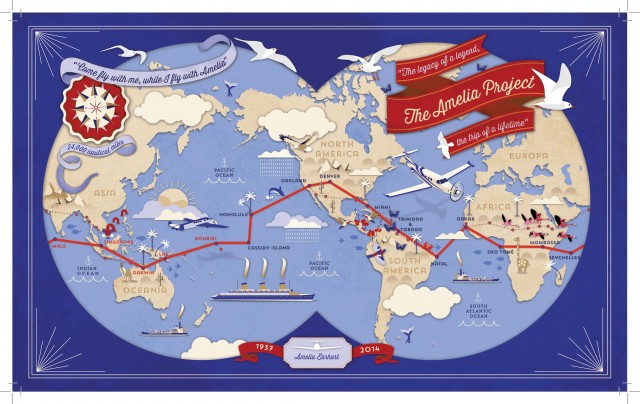
Amelia Rose Earhart’s route map to circumnavigate the globe – Image: Amelia Rose Earhart
Mal: What message do you have for young women, and men as well, who see your flight as inspiration to get into aviation?
Amelia: My advice is, if you feel it even in the slightest bit, if you feel that pull towards the adventure of getting into a plane and getting up into the sky, you have to explore it. It is going to nag at you for the rest of your life even if you think you have tucked it away in the back of your mind. For me, I have a great team helping me along, but in the beginning, no one else was paying for my flight lessons, no one was giving me fuel, no one was saying ’œhere take this opportunity and go fly.’
I worked three or four jobs at a time; I would get out there and bust my butt to raise enough money to take flight lessons and for a lot of people, that is exactly what it is going to take. In the end, it is absolutely worth it. There are difficult times where it is every last penny you have to get up in the sky, that is just the same kind of feeling I had on this adventure. We had a lot of people helping us out, but it was every last bit of my energy over the last year that I have poured my heart into it. Even though I was tired, hungry, and ready for the trip to come to a successful end, it felt so good to pour 100% of myself into one thing in my life. So that is how aviation should feel.
Mal: Now that the flight has finished, what direction are you going?
Amelia: So I am definitely going to stay in aviation. I left my job as a TV broadcaster, where I was working for NBC for eight years. I loved the job and I loved the flashiness of it, but my heart is absolutely up in the sky and when I don’t fly very often I have that pull, that desire, to get back up there. So now I can take the foundation to a whole new level, which is very exciting for me to know that we can put girls through flight school and create more AvGeeks, as you like to say.
We are writing books about the world flight, and the talk of the books isn’t just to say ’œhere is what happened on the flight around the world’ it is here is how to have your own version of a ’œflight around the world’, which is your personal adventure. It may have nothing to do with flying, there are so many metaphors and so many different aspects of flight to look at in terms of any adventure that you want to have. I definitely want to inspire a lot of people with that. I am working on a children’s book about a little girl who flies around the world and that will all go to benefit the Fly with Amelia Foundation.
Looking at the time Amelia spent around the world and hearing her words, I am absolutely inspired myself. Although I can’t get up in the air and fly my own plane around the world, I look at this journey as inspiration and remember that if I want something so badly, I just have to get out there and do it.
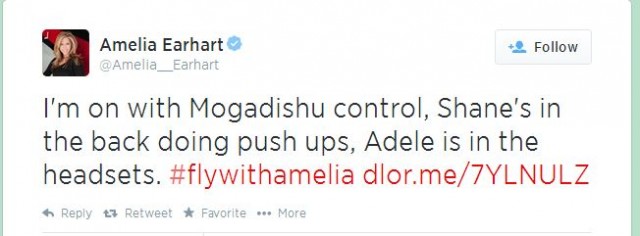
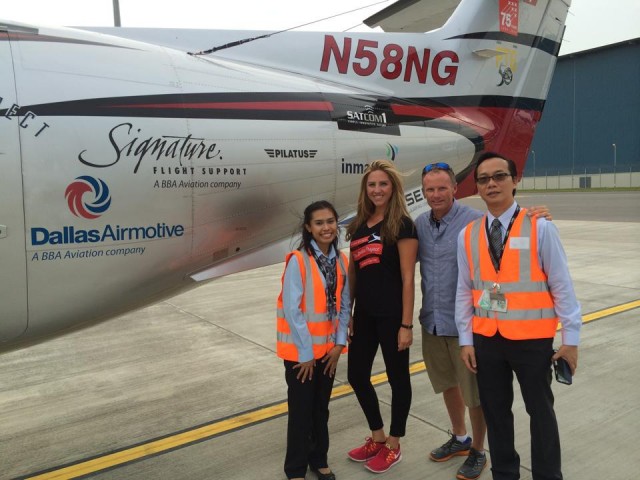
Excellent interview – very informative! Just one question: Paragraph two makes multiple references to “engines” (plural.) Um-m-m…Thought the Pilatus PC-12 was a single engine aircraft…Am I missing something here?